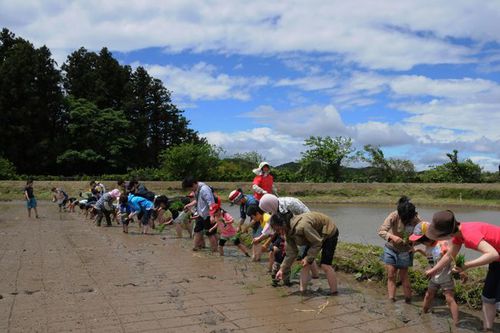January 1, 2018
Another Role for Igune (premises forest)
Keywords: Disaster Prevention / Reduction Ecosystems / Biodiversity Food Resilience

Copyright Shigeki Iwabuchi All Rights Reserved.
Tohoku Fukko Nikki (Tohoku Reconstruction Diary), a weekly feature in the Tokyo Shimbun newspaper, delivers news stories on reconstruction efforts in communities devastated by the earthquake and tsunami that struck Japan in March 2011. The articles are written by the JKSK Yui-Yui Project, an initiative to support survivors of the 2011 disaster by the non-profit organization JKSK Empowering Women Empowering Society. We present below an article that was published on June 6, 2017, in an issue about the role of Igune (Premises forest), or woodland homesteads.
Among the rice pests, shield bugs are most troublesome. These bugs, which are the size of a grain of rice, generate spotted paddy rice. Before the rice is fully ripe, the grains exist in a milky state. These bugs consume some of the liquid with their pointed mouths, leaving black spots on the rice. With more of these spots, the rice is downgraded, and it fetches a lower price at market.
Although pesticides can control these bugs, there are natural predators that can also eliminate them. Such predators include spiders that weave a dish-like web, and with large numbers present in chemical-free paddy fields, their webs provide beautiful scenery in the morning fog.
Where these spiders spend the winter was previously unknown, but last year's survey found that they spend winter in the trees surrounding farmhouses from Miyagi Prefecture to Iwate Prefecture. The trees surrounding farmhouses are known as Igune (Premises forest) in eastern Japan, the fact unknown to many.
Igune are already known to protect houses from winter hard winds, floods, and earthquake; however, Igune also provide homes for natural predators. From this perspective, frogs and dragonflies probably also live in Igune
Osaki tilled soil area refers to a common farming practice in the Osaki Flat Plain, which spreads throughout northern Miyagi Prefecture. In Osaki area, about 24,300 houses -- or 40 percent of all houses -- have Igune. This helped system to reduce the impact of the Great East Japan Earthquake, despite the most intense seismic activity among affected inland areas being recorded in this area. As a result, Osaki tilled soil area is now on its way to being approved as a Globally Important Agricultural Heritage System (GIAHS). *1
The ability of Igune to provide homes for natural predators maintains stable agricultural production by protecting rice from pests, which contributes to food self-sufficiency. People living in remote and isolated communities in the Osaki area reported being able to survive for more than a month without external aid or support in the aftermath of the Great East Japan Earthquake. *2
According to Japan's Ministry of Agriculture, Forestry and Fisheries (MAFF), GIAHS are specific agricultural systems authorized by the Food and Agriculture Organization of the United Nations (FAO). When an agricultural system that has been shaped through generations by adapting to society and the environment, is integrated into the culture, landscapes and biodiversity fostered by the agriculture, it becomes a GIAHS.
Agricultural villages with rich rural historical culture, as seen in Osaki and other GIAHS designated areas, tell us the importance of symbiotic systems to enhance biotic and cultural diversity.
Shigeki Iwabuchi
Representative
NPO Tambo
*1 Osaki Kodo's Traditional Water Management System is newly designated as GIAHS | FAO
*2 Information added by the author for this coverage at JFS.
Related
"JFS Newsletter"
- Fifth Contest to Award Excellent Environmental and Social Practices by Junior High, High School Students
- Coco Farm & Winery: An Amazing Model of Special Needs Students and Community
- Locally Produced Food in School Lunches----A Challenge by Nyuzen, Japan
- Seikatsu Club: Japanese Cooperative Managed by Members' Will to Confront Social Problems
- Increase Revenues without Increasing Catches -- How the Sustainable Sakura Shrimp Fishery in Suruga Bay Does It
Related
"Popular Articles"
- Yukiguni Maitake and Grameen Group Launching Joint Mung Bean Project in Bangladesh
- Japan's Food Self-Sufficiency Ratio Unchanged at 40% for 8 Years
- Food Pictograms Used at APEC SME Summit 2010
- Rental Organic Farm Provides Farmland for Housing Development Project
- Greenpeace Survey Ranks Five Top Japanese Supermarket Chains for Fish Safety, Finds Problems


